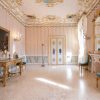Twenty rooms for Archdukes, Kings and Emperors
INFORMATION
Visit of the new itinerary only upon prior booking, accompanied by a specialized guide, for a maximum of 10 people.
It starts daily at established times according to the following schedule:
– in Italian at 14.00;
– in English at 10.30 and 15.30;
– in French at 12.00.
BOOK ONLINE YOUR ROYAL ROOMS ITINERARY >
–
Today you can visit the twenty splendid Royal Rooms one after the other and admire their splendour as well as the “pictures” of the real Venice visible from every balcony and window. In the past, groups of rooms were divided by double doors into separate apartments, served by independent entrances and staircases leading up from the courtyards, with corridors and service rooms at the back. The rooms, of different sizes and heights, were adapted to the use of the different royal courts throughout the 19th century, and underwent several transformations linked to events and personalities, reflecting the evolution of tastes and styles. However, the redesigned rooms retained and integrated earlier pieces and elements, giving the Royal Rooms their present eclectic appearance, where the not always uniform mix of decorations and furnishings creates unexpected arrangements, in tones of royal breadth and richness, alternating with others of more domestic intimacy.
After the strong ‘Empire’ imprint of the Napoleonic era, marked above all by the decorator Giuseppe Borsato, there was a general continuity and stylistic uniformity in the Habsburg period. Generations of talented Venetian painters collaborated with Borsato on scenes and figures: Giambattista Canal, Giovanni Carlo Bevilacqua, Pietro Moro, Francesco Hayez, Sebastiano Santi, Odorico Politi and others.
Later, in accordance with radically different styles and tastes, some rooms were renovated for the state visit of the young rulers Franz Joseph and Elisabeth, “Sissi”, which lasted thirty-eight days between November 1856 and January 1857. Sissi lived here again for seven months between October 1861 and May 1862, rarely appearing in public, her husband ‘Franzi’ often joining her by train from Vienna. At the same time, the Emperor’s brother, Archduke Ferdinand Maximilian, viceroy of Lombardy-Venetia in 1857-59, commissioned young Venetian artists (Giovanni Rossi, Leonardo Gavagnin, Federico Moja and others) to decorate and furnish his apartment with a personal taste, permeated by Orientalist suggestions (Moorish Room) and an intimate Biedermeier touch of Central European character.
The last transformations, limited to the renovation of the rooms at the end of the long row, took place with the arrival of the House of Savoy in 1866, mainly to create a new bedroom with living room and services for the King of Italy, Victor Emmanuel II. The apartment was then used by his successors, Umberto I and Margherita, Vittorio Emanuele III and Elena, until 1920. A rather heavy neo-baroque historicist taste, derived from the French style of Napoleon III, characterised the pictorial decorations of the ceilings and, above all, the furniture, rich in carvings, gildings, tapestries, inlays, etc.
In 1920, when the Royal Palace was closed, most of the twenty Royal Rooms overlooking the Giardini were divided up and used as offices by various state administrations. This incongruous use, which continued to damage the surviving decorations and furnishings until well after the year 2000, was brought to an end thanks to an agreement between the state bodies and the Venice Municipality. This paved the way for today’s full restoration and the opening of the Royal Rooms to the public, which began with a first group of rooms in 2012 and completed in 2022. The entire restoration has been supported by the generous private patronage of the Comité Français pour la Sauvegarde de Venise.











